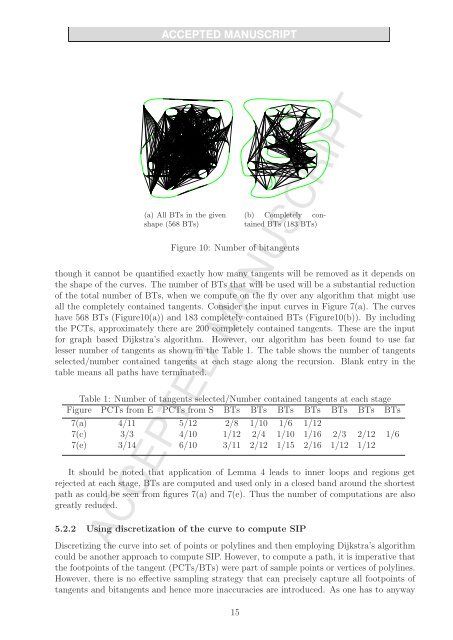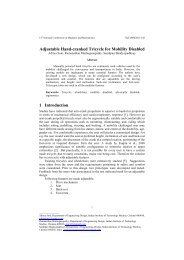Shortest path in a multiply-connected domain having curved ...
Shortest path in a multiply-connected domain having curved ...
Shortest path in a multiply-connected domain having curved ...
You also want an ePaper? Increase the reach of your titles
YUMPU automatically turns print PDFs into web optimized ePapers that Google loves.
(a) All BTs <strong>in</strong> the given<br />
shape (568 BTs)<br />
(b) Completely conta<strong>in</strong>ed<br />
BTs (183 BTs)<br />
Figure 10: Number of bitangents<br />
though it cannot be quantified exactly how many tangents will be removed as it depends on<br />
the shape of the curves. The number of BTs that will be used will be a substantial reduction<br />
of the total number of BTs, when we compute on the fly over any algorithm that might use<br />
all the completely conta<strong>in</strong>ed tangents. Consider the <strong>in</strong>put curves <strong>in</strong> Figure 7(a). The curves<br />
have 568 BTs (Figure10(a)) and 183 completely conta<strong>in</strong>ed BTs (Figure10(b)). By <strong>in</strong>clud<strong>in</strong>g<br />
the PCTs, approximately there are 200 completely conta<strong>in</strong>ed tangents. These are the <strong>in</strong>put<br />
for graph based Dijkstra’s algorithm. However, our algorithm has been found to use far<br />
lesser number of tangents as shown <strong>in</strong> the Table 1. The table shows the number of tangents<br />
selected/number conta<strong>in</strong>ed tangents at each stage along the recursion. Blank entry <strong>in</strong> the<br />
table means all <strong>path</strong>s have term<strong>in</strong>ated.<br />
Table 1: Number of tangents selected/Number conta<strong>in</strong>ed tangents at each stage<br />
Figure PCTs from E PCTs from S BTs BTs BTs BTs BTs BTs BTs<br />
7(a) 4/11 5/12 2/8 1/10 1/6 1/12<br />
7(c) 3/3 4/10 1/12 2/4 1/10 1/16 2/3 2/12 1/6<br />
7(e) 3/14 6/10 3/11 2/12 1/15 2/16 1/12 1/12<br />
It should be noted that application of Lemma 4 leads to <strong>in</strong>ner loops and regions get<br />
rejected at each stage, BTs are computed and used only <strong>in</strong> a closed band around the shortest<br />
<strong>path</strong> as could be seen from figures 7(a) and 7(e). Thus the number of computations are also<br />
greatly reduced.<br />
5.2.2 Us<strong>in</strong>g discretization of the curve to compute SIP<br />
Discretiz<strong>in</strong>g the curve <strong>in</strong>to set of po<strong>in</strong>ts or polyl<strong>in</strong>es and then employ<strong>in</strong>g Dijkstra’s algorithm<br />
could be another approach to compute SIP. However, to compute a <strong>path</strong>, it is imperative that<br />
the footpo<strong>in</strong>ts of the tangent (PCTs/BTs) were part of sample po<strong>in</strong>ts or vertices of polyl<strong>in</strong>es.<br />
However, there is no effective sampl<strong>in</strong>g strategy that can precisely capture all footpo<strong>in</strong>ts of<br />
tangents and bitangents and hence more <strong>in</strong>accuracies are <strong>in</strong>troduced. As one has to anyway<br />
15




